
Badajoz
- Mérida |
|

| Mérida (Extremaduran:
Méria) is the capital of the autonomous community of Extremadura,
Spain. It has a population of 55,568 (2008).
Among the remaining Roman monuments
are the Puente Romano, a bridge over the Guadiana River that is still used
by pedestrians, and the longest of all existing Roman bridges; an important
fortification to defend the bridge, and later used by the Moors, called
Alcazaba; the Temple of Diana; the remains of the Forum, including the
Arch of Trajan; the remains of the Circus Maximus; the Acueducto de los
Milagros (aqueduct); a villa called the Villa Mitreo; the Embalse de Proserpina
and Cornalvo reservoirs; the Circus, the Amphitheater, and the Teatro Romano,
where a summer festival of Classical theater is presented, usually with
versions of Greco-Roman classics or modern plays set in ancient times.
One can also visit the Morerías archaeological site, Santa Maria's
Cathedral, and many other locations all around the city to watch digging
in progress, as well as the Museo Nacional de Arte Romano (designed by
Rafael Moneo).
There are several notable buildings
built recently, such as the Escuela de la Administración Pública
(Public Administration College), the Consejerías y Asamblea de Junta
de Extremadura (councils and parliament of Extremadura), the Agencía
de la Vivienda de Extremadura (Housing Agency of Extremadura), the Biblioteca
del Estado (State Library), the Palacio de Congresos y Exposiciones (auditorium),
the Factoría de Ocio y Creación Joven (cultural and leisure
center for youth), the Complejo Cultural Hernán Cortés (cultural
center), the Ciudad Deportiva (sports city), the Universidad de Mérida
(Mérida University), the Confederación Hidrografica del Guadiana
(Guadiana Hydrographic Confederation designed by Rafael Moneo), the Puente
Lusitania (Lusitania Bridge over the Guadiana River designed by Santiago
Calatrava), the Palacio de Justicia (Justice Hall), etc. |

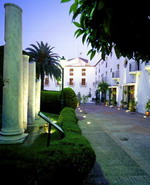 |
Parador
de Mérida, Mérida
The Hotel retains the structure
of the former 18th century convent, built over the remains of a temple
to the Concord of Augustus. It offers guests an opportunity to enjoy the
rich heritage of the lovely city of Mérida and the landscape around
it. Some of the most outstanding spaces are the hotel lounge in the
former convent refectory, the interior courtyard and the beautiful gardens,
including the “Garden of Antiquities”, an archaeological collection consisting
of Mudejar, Roman and Visigoth elements. Taste the exquisite local
dishes, including caldereta (lamb stew), assorted gazpachos, figs from
Almoharín and naturally, truffles. |

Badajoz
- Zafra |
|

| Zafra
- One of the most interesting
stopovers in lower Extremadura, the white-walled town of Zafra is filled
with old Moorish streets and squares. The 1457 castle of the dukes of Feria,
the most important in the province, boasts both a sumptuous 16th-century
Herreran patio and the Sala Dorada with its richly paneled ceiling - this
building has now been converted into a Parador - details below. |

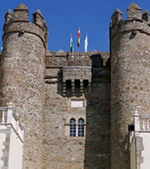 |
Parador
de Zafra, Zafra, Badajoz
The Hotel "Duque de Feria"
in Zafra occupies a majestic castle which was begun in 1437 as the residence
of the Dukes of Feria, one of Spain’s great families. The spectacular
façade expresses the importance of this castle-palace, which is
the ideal base for exploring the architectural heritage and the natural
beauties of the area. Nine towers with battlements stand guard over
a regal, grandiose interior which conserves beautiful coffered ceilings,
trunks, ironwork, balustrades and other decorative details from the former
palace. The bedrooms, which still have their ducal coffered ceilings
and decorative details, are lordly, elegant and spacious. The swimming
pool and well-tended garden are also worth a mention. The best local dishes
are offered in the dining room of the Parador de Zafra, such as caldereta
de cordero (lamb stew), migas extremeñas (breadcrumbs), bacalao
monacal (cod), zorongollo (tomato salad), cheesecake from La Serena, Iberian
pork loin with Ibores cheese, and, of course, ham. |

Cáceres |
|

| Cáceres
- capital
of Cáceres province in Extremadura. Products of cork, leather, pottery,
and cloth are made there. Cáceres was an important Roman colony.
It fell to the Moors in the 8th century but was recaptured (1229) by Alfonso
IX. The old town, on top of a hill and encircled by turreted walls, has
many notable Roman and Moorish structures. |

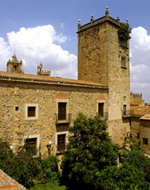 |
Parador
de Cáceres, Cáceres
The ancient Torreorgaz Palace
is built on Arabic foundations with a linteled door and a Baroque coat
of arms. It is in the heart of the Cáceres's old town and artistic
centre, which has been declared a World Heritage Site. This 14th Century
Parador, overlooked by its narrow tower, was founded by Diego García
de Ulloa, knight of the Order of Santiago. Gothic, Renaissance and Baroque
styles are reflected in the building and its surroundings. Its internal
courtyard, cobbled exterior, exposed wooden beams, and the lounge's original
mantelpiece make up the hotel's interior decoration. The bedrooms, decorated
in soft shades of cream are tasteful, spacious and comfortable. Rosemary
roast goat kid, merluza a la cacereña (hake dish), ancas de rana
a lo mozárabe (Arabic-style frogs’ legs), roast young lamb shank
with patatas a lo pobre (potatoes with green peppers and onions), and roast
suckling pig... Where do you begin? The hotel also has a wine-cellar
featuring more than 300 varieties of Spanish wine. |

Cáceres
- Guadalupe |
|

| Guadalupe
- noted for its
monastery (formerly Hieronymite, now Franciscan) and the shrine of Our
Lady of Guadalupe, whose cult was transferred in the 16th century to Guadalupe
Hidalgo, Mexico. The area is still a pilgrimage center. |

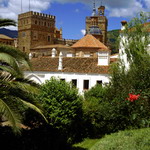 |
Parador
de Guadalupe - Caceres Province
The hotel is housed in an
old hospital that was intended for pilgrims in the 15th century. The parador
takes its name of' Zurbaran' from the fact that the adjacent Guadalupe
monastery preserves a collection of pictures by this famous artist. The
impressive fortress-monastery of Guadalupe is a centre of pilgrimage in
the region of Extremadura. They are decorated in rustic style. Most
of them are located around the inner square. spacious common rooms on the
inside with white walls and bedrooms which recall the religious function
as convent. Monastic cod, Extemadura ajo blanco (almond and garlic
gazpacho), Extremadura migas, Iberian sausages, lamb stew, chestnut pudding,
Guadalupe muégano cookie. Savour the simple local cuisine and bon
appétit! |

Cáceres
- Jarandilla de la Vera |
|

| Jarandilla de la Vera
- Monumental
town with a castle and monastery, located approximately 230 kms from Madrid. |

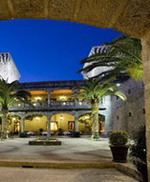 |
Parador
de Jarandilla de la Vera - Cáceres Province
The palace-castle lies sheltered
in the middle of the Vera and Tiétar valley, between gorges filled
with water, woods of chestnut trees and oak groves and stunningly beautiful
natural landscapes that reaffirm the richness of their historical, majestic
surroundings. For months it played host to an illustrious guest - Emperor
Carlos V. From the exterior the towers, the courtyard, the patio
de armas courtyard and its excellent swimming pool contrast with the olive
and orange trees. Inside you will find a relaxing and intimate atmosphere.
Enjoy the exquisite Extremaduran gastronomy: tomato soup, pucherete de
perdiz (partridge stew), lomitos de cordero asados a la miel de la dehesa
(honey roast lamb), migas extremeñas (garlic breadcrumbs) and, above
all, tarta de bellota extremeña con sus bomboncitos (acorn cake
with chocolate drops). |

Cáceres
- Plasencia |
|

| Plasencia
- is a walled market
city in the province of Cáceres. The focal point of the old
city is the market square (Plaza Mayor), where a weekly tax-free market
has been in operation every Tuesday since the foundation of the city. |

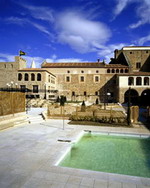 |
Parador
de Plasencia, Plasencia, Cáceres Province
The hotel is in the former
15th-17th century convent of Sto. Domingo, founded by the Zúñiga
family in the mid 15th century, in the Gothic style inside and in part
of the exterior. Strategically located in the historic centre of
Plasencia, this is the ideal place to explore the architectural beauty
of this singular city and the beautiful landscape around it. Try the exquisite
cooking of Extremadura: Potato soup, partridge stew, lamb with local honey,
compote of figs from La Vera, and the famous migas. During your next stay
in Plasencia, don't miss our night bar - A place to have conversation with
friends, to feel well with your partner, a space to find relaxation.
We have selected the best jazz music, both instrumental and vocal; a warm
and soft illumination with dozens of candles and a selection of the best
beverages together with the best service. |

Extremadura
- Trujillo |
|

| Trujillo
- A beautiful small
town with many restaurants and bars. Perched on a hill some 580 meters
above sea level, dominating an extensive plain between Extremadura's two
major rivers the Tagus and the Guadiana, lie the Towers of Trujillo. Trujillo
is crowned by its Moorish Castle, built on Roman foundations, ramparts
and fortifications.
Just a few miles from Monfragüe's
National Park, Trujillo sits in a privileged location. It is merely
47 km from Cáceres, one hour by car from Guadalupe, 90 km from Mérida,
Plasencia and Navalmoral de la Mata. Easy connection with Madrid is made
possible by a motorway, the A-5, stretching for 250 km. |

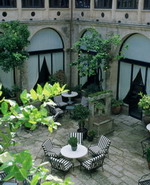 |
Parador
de Trujillo, Trujillo
This hotel is situated in
the converted Santa Clara convent which was founded by the order of the
conceptionists in the 16th century. The convent building is simply laid
out around a central cloister which now has three renaissance fountains
and lovely plants and trees growing around them. Nuns used to live
in the convent until it was converted into a hotel, therefore their cells
have been used as rooms for guests. There are 45 doubles and a suite, distributed
around a renaissance cloister and its well, with views of the town or nearby
fields. The refectory, a vaulted room with a magnificent tiled wall
is where international and Regional cuisine can be sampled. Ideal
for rest, leisure work, the Parador has monastic style common rooms and
details, spacious, quite and pleasant living rooms, noble bedrooms in which
wood takes preference. |
Top
|

